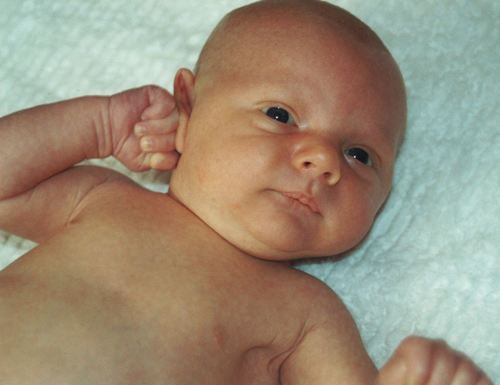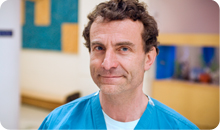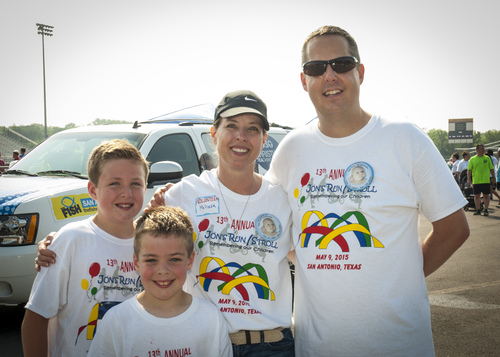
Melissa French-Stephenson and David Stephenson know the devastation of losing a baby to Sudden Infant Death Syndrome (SIDS). In 2002, they lost their 3-month-old, Jon, to SIDS while he was at daycare. He was their first baby.
“We were late to daycare because he was in such a good mood that morning and we spent some time playing,” French-Stephenson said. “We have a video from earlier that week where he is laughing, smiling and kicking.”
The Stephensons, who live in San Antonio, Texas, now have two healthy boys, but they wanted to honor Jon’s legacy. They founded Jon’s Run, an organization that hosts a yearly 5K run that supports families who have lost a baby or young child and raises money for SIDS research.
“When you lose a baby to SIDS, you feel like they never had a chance to get started in life,” French- Stephenson said. “We were devastated when we lost Jon and felt it was important to bring other parents together who had lost a child to SIDS, or from any cause, to support each other in their grief.”
The Stephensons are committed to advancing SIDS research and Jon’s Run recently donated $20,000 to support a study by Dr. Daniel Rubens, an anesthesiologist at Seattle Children’s Hospital and principal investigator at Seattle Children’s Research Institute. Rubens will investigate a possible association between SIDS and hearing abnormalities in newborns.
“We’re excited to support Dr. Rubens’ work and hope answers come from this research,” French-Stephenson said.
Looking for an answer in the ears

Rubens is partnering on a study called the Oto-Acoustic Signals in SIDS (OASIS) study that will investigate a possible association between SIDS and hearing abnormalities on the newborn hearing test. He is working with The Lullaby Trust in the United Kingdom and Dr. Peter Fleming, pediatrician and professor at Bristol University, to launch the study in May.
“We keep working away to understand the cause of sudden infant deaths, and we are not giving up,” Rubens said. “Solving SIDS is our mission. This study will give researchers access to comprehensive data that could yield important insights into how an infant’s hearing and associated risk factors can impact the risk for SIDS. What is most promising about this study is that we are considering a way to detect infants at risk well before a potential fatal event.”
SIDS is defined as the sudden death of an infant less than 1 year of age that cannot be explained after a thorough investigation including an autopsy, examination of the death scene and a review of clinical history. According to the Centers for Disease Control, SIDS is the leading cause of death in infants 1 to 12 months old. About 2,000 babies born in the United States die each year from SIDS.
Rubens thinks that babies with inner ear damage are not able to wake up or move themselves away from danger if their breathing is compromised. The babies suffer from a lack of oxygen and build up of carbon dioxide in their bodies while asleep and they can die.
“Parents can do everything correctly and this can still happen,” he said. “We are not suggesting that SIDS only occurs because of inner ear dysfunction. Rather, we believe the inner ear plays an important role in relaying vital information to other areas of the brain involved in survival. If this region is damaged, I believe it is part of the underlying specific condition that leads to SIDS.”
Working to understand and prevent SIDS
The study will examine the newborn hearing tests and death records of babies who have died of SIDS, and compare those with newborn hearing tests of babies born during the course of the study. The team will examine the data for patterns that indicate that abnormal hearing test results may increase the risk of SIDS. In addition, the teams will interview mothers of babies about lifestyle habits such as smoking, diet and sleeping position of babies, which are all known to affect the risk of SIDS.
The team will conduct the study in the United Kingdom because newborn hearing tests and infant death records are standardized and the data is consistent across the country. In the United States, infant hearing tests and death reports are inconsistent because each state and county has its own process.
“The ultimate goal of the research is to develop a screening tool at birth that would identify infants at high risk for unexpected sudden death,” Rubens said. “This could allow targeted monitoring and therapeutic interventions immediately after birth for the first time, and would potentially further reduce the number of SIDS deaths.”
The OASIS study complements research that Rubens is doing with Dr. Marta Cohen, a pediatric pathologist at Sheffield Children’s in the United Kingdom, where they are looking at CT and MRI imaging of the inner ear during autopsies of unexpected infant deaths. Rubens is also working with Dr. Nino Ramirez at Seattle Children’s Research Institute to study inner ear and vestibular system dysfunction in animal models.
Research in action thanks to donors

The OASIS study was made possible by generous gifts from donors including Jon’s Run, The Fred H. and Mary S. Dore Charitable Foundation, the SIDS Research Guild at Seattle Children’s Hospital, The Lullaby Trust, Teddy’s Wish, Joshua Ruben, and the Richardson and Gooden families.
“We are delighted and extremely grateful for the generous support we have received for this research,” Rubens said. “We hope in time that our work will yield solutions for preventing SIDS deaths and provides families with tools to keep their newborn babies safe.”
French-Stephenson says it’s important that families who lose babies to SIDS are proactive in dealing with their grief and remember the children they lost.
“When Jon died, we got counseling and started the 5K race to raise awareness and support research,” she said. “Our work to fund SIDS research is a way of finding meaning in Jon’s life.”
To support SIDS research at Seattle Children’s, visit www.sidsguild.org.
Resources
- SIDS guild: www.sidsguild.org
- Dr. Daniel Rubens, Seattle Children’s
- Lullaby Trust website
- Seattle Children’s On the Pulse blog: New research shows link between SIDS and inner ear damage
- Research milestones at Seattle Children’s, 2015 Academic Annual Report

